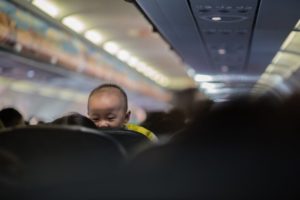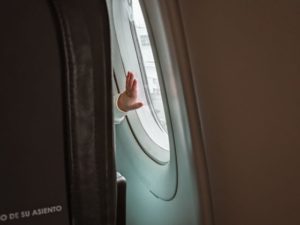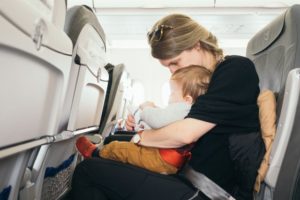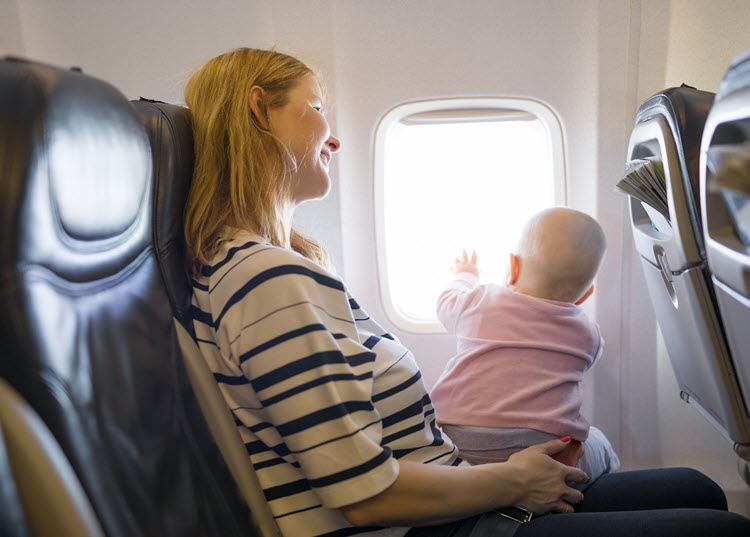Tips for flying with a baby are invaluable for that first or second or even your third trip with a little one. Preparation is your friend. From packing to preboarding, there are many ways you can ease stress to keep your baby happy and you calm.
1. Book a Direct Flight

Photo by Octav Cado on Unsplash
Direct flights are easier with babies for many reasons. Most notably, landing is when the pressure changes in your baby’s ears will be the most uncomfortable.1 The fewer times you have to do that, the better. Direct flights also reduce stress because you’re not worried about making a connecting flight. While it’s not always possible to stay on one plane for an entire journey, it’s best to try if you can.
2. Or Get an Extended Layover
When direct flights aren’t possible, try to schedule a little extra time, two to three hours, between connecting flights. It can be tough to sprint through the airport with a baby and all your gear. That extra time will let you get to your gate and have a chance to attend to your baby’s needs before hopping back on a plane.
3. Visit the Restroom and Change Diapers Before Your Flight
Your itinerary should list when boarding begins. Around 20 to 30 minutes before boarding starts, change your baby’s diaper and use the restroom. You still might need to change a diaper in-flight, but it always helps to start the flight with a clean diaper.
4. Have a Plan for Uncomfortable Ears
Some babies aren’t bothered by air pressure changes, but you want to be prepared just in case. You can relieve air pressure by giving your baby something to suck on, like a pacifier, or offering a bottle or breastfeeding. The biggest changes in air pressure happen at takeoff and landing, so have your pressure relief methods ready to go.2
Try to postpone flying altogether if your baby has a cold. If you can’t, give your baby a pain reliever before leaving the ground.3 If nothing else works, try rubbing your baby’s ears to stimulate the pressure change.
5. Gate Check Your Stroller and Other Baby Gear
Most airlines allow you to gate check travel strollers and car seats at no additional cost. They may even encourage it to open room in the cabin. Put a tag on each item and leave it just outside the plane door before entering. Make sure to ask where to pick up your items when you gate check them. Most airlines leave the items in the same place at the arrival destination, but some send the items to the baggage claim.
6. Buy a Ticket for Your Baby

Photo by Michelle Spollen on Unsplash
Children under two can ride on your lap,4 but there are two main reasons why buying them their own seat and ticket are a good idea. First, it’s safer. Your arms do not have the strength to hold your baby in an emergency or severe turbulence. It’s safer for them to be secured in a car seat in their own seat.5 Second, a separate seat gives you more room on the plane. You’ll also reduce your chances of bumping into another passenger.
7. Secure Those Buckles
For safety reasons, most airlines ask passengers to wear their seatbelts if they are seated. It makes sense that your baby will be safer buckled into their car seat as well. When the flight attendants indicate that it’s safe to get the baby out, you can, of course, do so.
8. Say Yes to Preboarding
No matter what class or ticket level you have, if you’re traveling with a baby, you can take advantage of preboarding. It’s much easier to navigate the plane with all of your baby gear and baby when the plane isn’t full yet. You can get your car seat installed and carry-ons set before anyone else gets on the plane. You also have a chance to talk to the flight attendants about any special needs you may have.
9. Bring Twice as Much
Unfortunately, flights get canceled, and planes can get delayed while on the tarmac. Pack twice as many diapers, formula, wipes, and other baby supplies you may need. That way, if you’re stuck in the airport or on a plane for five hours, you’ve got the necessities at hand.
10. Pack Extra Clothes
Most parents keep a change of clothes for their baby in the diaper bag. Pack an extra set in case you end up with an unexpected delay. However, you probably want a change of clothes for yourself too. If your baby has a blowout, gets airsick, or spits up, you’ll have the option to change into fresh clothes.
11. Be Prepared to Play

Photo by Paul Hanaoka on Unsplash
Unless your baby is taking a nap, you’ll probably be entertaining your little one for most of the flight. Bring along plenty of toys and snacks. It might be worth investing in a few new toys so there is a novelty factor to keep your baby’s attention. If your baby has a favorite board book, bring it along and be prepared to read it over and over again.
12. Take Medications in Your Carry On
Lost luggage is a reality of flying. You don’t want to be caught at your destination without your baby’s medications. Pack them in your carry-on so they’re always with you. It can also be helpful to have a pain reliever with you in case your baby gets fussy from pressure changes.
13. Stay Hydrated
The circulating air on an airplane is notorious for causing dehydration.6 You’ll need plenty of liquids for you and your baby. For your baby, that might mean extra formula or planning on getting water from the flight attendant. You can buy bottled water at the airport or fill your water bottle after you’ve come through security. Take a sip every 15-20 minutes to keep yourself well hydrated.
14. Consent to Travel
If your baby’s other parent won’t be traveling with you and you’re on an international flight, call the airline in advance to find out what kind of documentation they require. You may need your baby’s birth certificate and a notarized letter of consent from the baby’s other parent to board.7
15. Don’t Be Afraid to Ask
Flight attendants are used to working with young families. If you’ve got questions once you get on board or if you need help with something, ask for help. The worst they can do is say no, but most of the time, they’re pretty accommodating. Things like warming formula or if you need extra napkins or wipes to clean up a mess, they’re usually more than happy to help.
Article Sources
Safe Smart Family uses only high-quality sources, including peer-reviewed studies, to support the facts within our articles. Read our editorial process to learn more about how we fact-check and keep our content accurate, reliable, and trustworthy.
- Hoecker JL. Is air travel safe for an infant? Mayoclinic.org. Published February 25, 2022. Accessed May 20, 2022.
- Canadian Paedriatric Society. Air travel and children. Paediatr Child Health. 2007;12(1):51-63. doi:10.1093/pch/12.1.51
- Beth Israel Lahey Health Winchester Hospital. Traveling with a newborn baby: by plane. Winchesterhospital.org. Accessed May 20, 2022.
- U.S. Department of Transportation. Family seating. Transportation.gov. Updated December 23, 2021. Accessed May 20, 2022.
- Federal Aviation Administration. Flying with children. Faa.gov. Updated March 19, 2021. Accessed May 20, 2022.
- Cleveland Clinic. 6 Ways airplane travel affects your body + how you can prepare. Health.clevelandclinic.org. Published December 14, 2018. Accessed May 20, 2022.
- U.S. Customs and Border Protection. Before your trip. Cbp.gov. Updated July 22, 2019. Accessed May 20, 2022.


